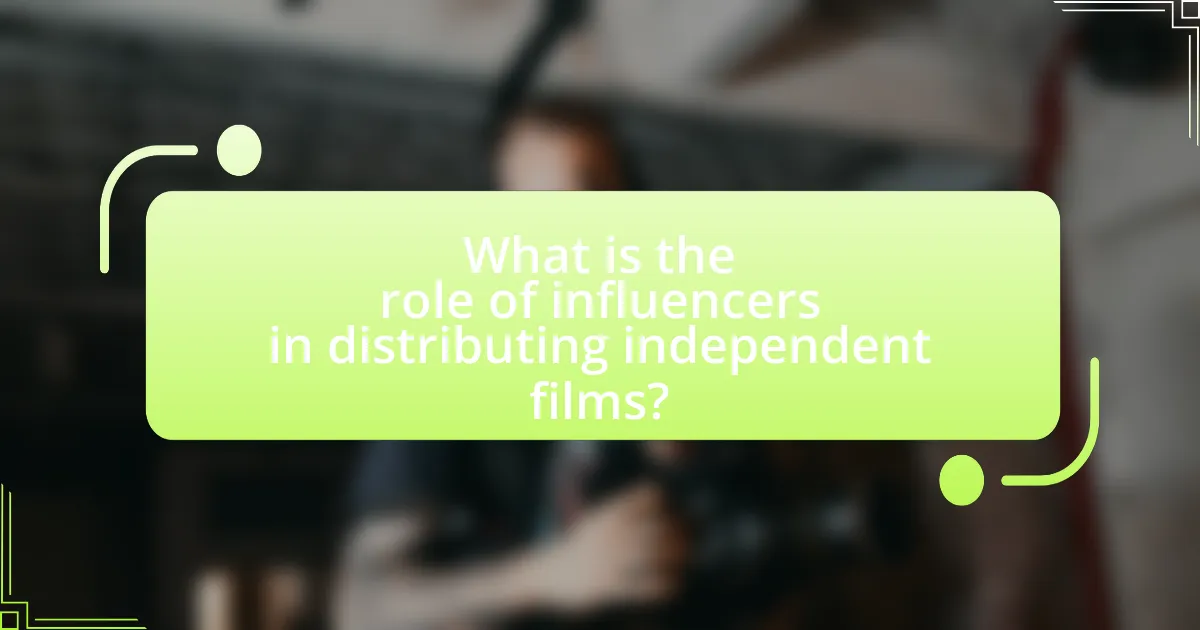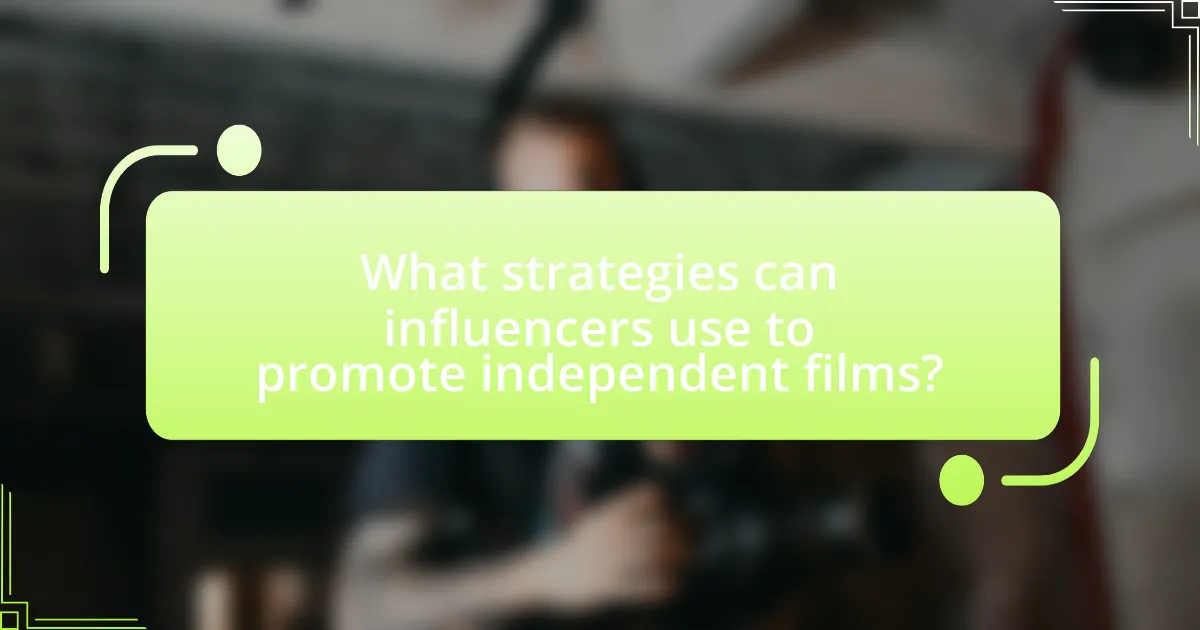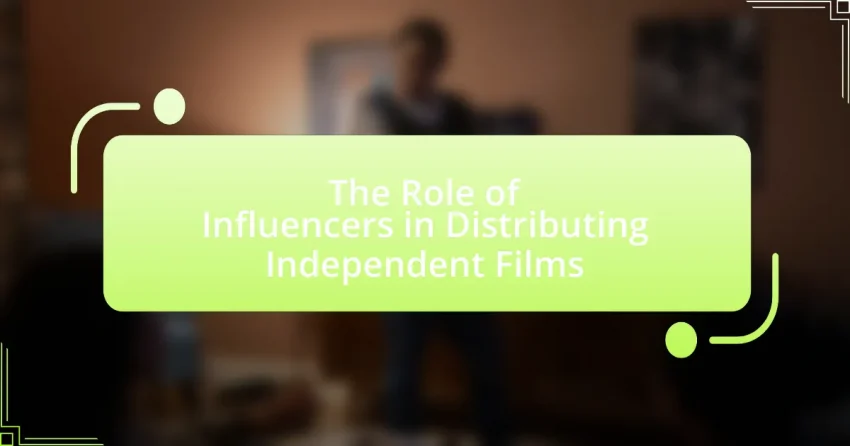The article examines the significant role of influencers in the distribution of independent films, highlighting their ability to enhance visibility and drive audience engagement through social media platforms. It discusses how influencers create awareness by sharing trailers, reviews, and personal endorsements, leading to increased ticket sales and viewership. The article also explores the various platforms used by influencers, the impact of their engagement on audience reach, and the challenges they face, such as budget constraints and potential misalignment with film messages. Additionally, it outlines effective strategies for collaboration between influencers and filmmakers, emphasizing the importance of authenticity and ethical standards in promotional efforts.

What is the role of influencers in distributing independent films?
Influencers play a crucial role in distributing independent films by leveraging their social media platforms to reach targeted audiences. They create awareness and generate buzz around these films, often sharing trailers, reviews, and personal endorsements that can significantly increase viewership. For instance, a study by the University of Southern California found that films promoted by influencers saw a 30% increase in ticket sales compared to those without influencer support. This demonstrates that influencers not only enhance visibility but also drive audience engagement and financial success for independent films.
How do influencers impact the visibility of independent films?
Influencers significantly enhance the visibility of independent films by leveraging their large and engaged audiences on social media platforms. Their endorsements and promotional content can create buzz and generate interest, leading to increased viewership and awareness. For instance, a study by the University of Southern California found that films promoted by influencers experienced a 20% increase in ticket sales compared to those without influencer support. This demonstrates that influencers play a crucial role in connecting independent films with potential audiences, ultimately driving their success in a competitive market.
What platforms do influencers use to promote independent films?
Influencers use platforms such as Instagram, YouTube, TikTok, and Twitter to promote independent films. These platforms allow influencers to reach diverse audiences through visual content, storytelling, and engagement. For instance, Instagram’s visual-centric approach enables influencers to share trailers, behind-the-scenes footage, and promotional posts, while YouTube provides a space for longer-form content like interviews and reviews. TikTok’s short video format allows for creative and viral marketing strategies, and Twitter facilitates real-time conversations and updates about film releases. The effectiveness of these platforms is supported by statistics showing that 54% of consumers rely on social media influencers for product recommendations, highlighting their significant impact on audience engagement and film promotion.
How does influencer engagement affect audience reach?
Influencer engagement significantly enhances audience reach by leveraging the influencer’s established trust and connection with their followers. When influencers actively interact with their audience through comments, shares, and personalized content, they create a sense of community and authenticity that encourages their followers to engage with the promoted content. Research indicates that posts with higher engagement rates can lead to a 50% increase in reach compared to those with minimal interaction, as seen in studies conducted by the Digital Marketing Institute. This dynamic allows independent films to tap into niche audiences effectively, amplifying visibility and driving viewership through the influencer’s network.
Why are influencers important for independent filmmakers?
Influencers are important for independent filmmakers because they provide a platform for increased visibility and audience engagement. By leveraging their established follower base, influencers can promote independent films to a wider audience, often reaching demographics that traditional marketing methods may not effectively target. For instance, a study by the Influencer Marketing Hub found that 49% of consumers depend on influencer recommendations when making purchasing decisions, highlighting the significant impact influencers have on audience behavior. This ability to drive awareness and interest can be crucial for independent filmmakers who often operate with limited marketing budgets and resources.
What advantages do influencers provide over traditional marketing methods?
Influencers provide targeted reach and authentic engagement that traditional marketing methods often lack. Unlike traditional advertising, which typically broadcasts messages to a broad audience, influencers connect with specific demographics, ensuring that marketing efforts resonate with potential viewers. For instance, a study by the Digital Marketing Institute found that 49% of consumers depend on influencer recommendations, highlighting their effectiveness in shaping purchasing decisions. Additionally, influencers foster a sense of community and trust, as their followers often view them as relatable figures, leading to higher conversion rates compared to conventional ads.
How do influencers help in building a film’s community?
Influencers help in building a film’s community by leveraging their established audiences to create awareness and engagement around the film. They utilize social media platforms to share content related to the film, such as trailers, behind-the-scenes footage, and personal endorsements, which fosters a sense of connection among fans. For instance, a study by the Pew Research Center indicates that 72% of teenagers engage with influencers, making them effective in reaching younger demographics who are crucial for independent films. This engagement not only increases visibility but also encourages discussions and interactions among viewers, thereby strengthening the film’s community.
What challenges do influencers face in promoting independent films?
Influencers face several challenges in promoting independent films, primarily due to limited budgets and audience reach. Independent films often lack the marketing resources that larger studios possess, making it difficult for influencers to create impactful promotional content. Additionally, influencers may struggle to engage their audiences with niche films that do not align with mainstream interests, resulting in lower visibility and engagement rates. According to a 2021 study by the University of Southern California, 70% of independent films fail to secure adequate promotional support, which directly affects influencers’ ability to generate buzz and drive viewership.
How do budget constraints affect influencer partnerships?
Budget constraints significantly limit the scope and scale of influencer partnerships. When a film’s budget is tight, it often restricts the ability to engage high-profile influencers who command higher fees, leading to a reliance on micro-influencers or those with smaller followings. Research indicates that micro-influencers can yield higher engagement rates, with a study by Markerly showing that influencers with fewer than 1,000 followers have an engagement rate of 8%, compared to 1.6% for those with over 100,000 followers. This shift can affect the overall reach and impact of marketing campaigns, as smaller influencers may not have the same audience size but can foster more authentic connections with their followers. Consequently, budget constraints necessitate strategic choices in influencer selection, often prioritizing cost-effectiveness over reach.
What are the risks of influencer marketing for independent films?
The risks of influencer marketing for independent films include potential misalignment between the influencer’s brand and the film’s message, which can lead to audience disengagement. If an influencer promotes a film that does not resonate with their established persona or values, it may result in negative backlash or reduced credibility for both the influencer and the film. Additionally, there is a risk of financial investment without guaranteed returns, as influencer campaigns can be costly and may not yield the expected audience reach or engagement. According to a study by Influencer Marketing Hub, 49% of marketers reported that measuring ROI from influencer marketing is challenging, highlighting the uncertainty involved in such strategies. Furthermore, reliance on influencers can lead to a lack of control over the narrative and messaging, as influencers may interpret or present the film in ways that do not align with the filmmakers’ intentions.

How do influencers collaborate with independent filmmakers?
Influencers collaborate with independent filmmakers primarily through promotional partnerships that enhance visibility and audience reach. By leveraging their established social media platforms, influencers can share trailers, behind-the-scenes content, and personal endorsements, which significantly increase the film’s exposure to potential viewers. For instance, a study by the Influencer Marketing Hub indicates that 49% of consumers depend on influencer recommendations when making purchase decisions, showcasing the effectiveness of such collaborations in driving audience engagement for independent films.
What types of collaborations exist between influencers and filmmakers?
Collaborations between influencers and filmmakers primarily include promotional partnerships, content creation, and co-productions. In promotional partnerships, influencers leverage their social media platforms to market a film, increasing its visibility and audience reach. Content creation involves influencers participating in behind-the-scenes footage, interviews, or vlogs that provide audiences with exclusive insights into the filmmaking process. Co-productions occur when influencers are involved in the creative process, contributing to script development or acting roles, which can enhance the film’s appeal to their followers. These collaborations are effective as they tap into the influencer’s established audience, thereby driving engagement and viewership for independent films.
How do influencers contribute to film festivals and screenings?
Influencers contribute to film festivals and screenings by amplifying visibility and engagement for independent films. Their large social media followings allow them to reach diverse audiences, generating buzz and interest around specific films or events. For instance, influencers often share behind-the-scenes content, interviews with filmmakers, and live coverage of festival events, which can significantly increase attendance and viewership. According to a study by the Pew Research Center, 72% of teens and young adults follow influencers, indicating their substantial impact on shaping public interest in cultural events like film festivals.
What role do influencers play in crowdfunding campaigns for independent films?
Influencers play a crucial role in crowdfunding campaigns for independent films by leveraging their established audiences to generate awareness and attract potential backers. Their ability to reach large, engaged followings allows filmmakers to tap into new networks, significantly increasing the visibility of their projects. For instance, a study by the University of Southern California found that campaigns promoted by influencers raised 30% more funds on average compared to those without influencer support. This demonstrates that influencers not only enhance the reach of crowdfunding efforts but also contribute to higher funding success rates.
How can filmmakers effectively choose the right influencers?
Filmmakers can effectively choose the right influencers by assessing their audience alignment, engagement rates, and content relevance. Audience alignment ensures that the influencer’s followers match the target demographic of the film, which is crucial for maximizing reach and impact. Engagement rates, such as likes, comments, and shares, indicate how actively the influencer interacts with their audience, reflecting their influence and potential effectiveness in promoting the film. Content relevance involves evaluating whether the influencer’s previous work and interests resonate with the film’s themes and genre, ensuring authenticity in the promotion. Research shows that 49% of consumers depend on influencer recommendations, highlighting the importance of selecting influencers who can genuinely connect with the film’s audience.
What criteria should filmmakers consider when selecting influencers?
Filmmakers should consider the influencer’s audience alignment, engagement rates, and content relevance when selecting influencers. Audience alignment ensures that the influencer’s followers match the target demographic of the film, which can enhance reach and impact. Engagement rates, measured by likes, comments, and shares, indicate how actively the influencer interacts with their audience, suggesting potential effectiveness in promoting the film. Content relevance refers to the influencer’s niche and the type of content they produce, which should resonate with the film’s themes or genre to create authentic promotion. For instance, a study by Influencer Marketing Hub found that campaigns with highly engaged influencers can yield up to 11 times higher ROI compared to traditional advertising methods, underscoring the importance of these criteria.
How can filmmakers assess an influencer’s audience alignment?
Filmmakers can assess an influencer’s audience alignment by analyzing demographic data, engagement metrics, and content relevance. Demographic data includes age, gender, location, and interests of the influencer’s followers, which should match the target audience of the film. Engagement metrics, such as likes, shares, and comments, indicate how actively the audience interacts with the influencer’s content, reflecting their investment in the influencer’s recommendations. Additionally, the relevance of the influencer’s content to the film’s themes or genre is crucial; influencers who regularly discuss similar topics are more likely to resonate with the film’s intended viewers. This method ensures that the influencer’s audience is not only large but also aligned with the film’s marketing goals.

What strategies can influencers use to promote independent films?
Influencers can promote independent films by leveraging their social media platforms to create engaging content that highlights the film’s unique aspects. They can host live Q&A sessions with the filmmakers or cast, share behind-the-scenes footage, and post reviews or recommendations to their followers. For instance, influencers with a strong following in niche genres can target specific audiences, increasing the film’s visibility among potential viewers. According to a study by the Digital Marketing Institute, 49% of consumers depend on influencer recommendations, demonstrating the effectiveness of this strategy in reaching and engaging audiences.
What content strategies are effective for influencers in film promotion?
Effective content strategies for influencers in film promotion include creating engaging behind-the-scenes content, leveraging storytelling techniques, and utilizing interactive formats like polls and Q&A sessions. Behind-the-scenes content provides audiences with exclusive insights, fostering a deeper connection to the film. Storytelling techniques, such as sharing personal experiences related to the film’s themes, enhance emotional engagement and relatability. Interactive formats encourage audience participation, increasing visibility and engagement rates. Research indicates that posts with interactive elements can boost engagement by up to 50%, demonstrating the effectiveness of these strategies in reaching and influencing potential viewers.
How can influencers leverage storytelling to engage audiences?
Influencers can leverage storytelling to engage audiences by creating relatable narratives that resonate emotionally with their followers. By sharing personal experiences, challenges, and successes related to the independent films they promote, influencers can foster a deeper connection with their audience. Research indicates that storytelling can increase audience retention by up to 65%, as narratives help to create memorable and impactful content. This emotional engagement not only enhances the audience’s interest in the influencer’s message but also encourages them to support the independent films being showcased.
What role does authenticity play in influencer marketing for films?
Authenticity is crucial in influencer marketing for films as it fosters trust and engagement among audiences. When influencers genuinely connect with the film’s themes or message, their endorsements resonate more deeply with their followers, leading to increased interest and viewership. Research indicates that 92% of consumers trust recommendations from individuals over brands, highlighting the importance of authentic influencer partnerships. For instance, influencers who share personal stories related to a film can create a more relatable narrative, enhancing the film’s appeal and driving ticket sales.
How can influencers measure the success of their promotional efforts?
Influencers can measure the success of their promotional efforts through key performance indicators (KPIs) such as engagement rates, reach, conversion rates, and return on investment (ROI). Engagement rates, which include likes, comments, and shares, indicate how well the audience interacts with the content. Reach measures the total number of unique users who see the promotional content, providing insight into visibility. Conversion rates track the percentage of users who take a desired action, such as visiting a website or making a purchase, directly linked to the promotional efforts. ROI quantifies the financial return generated from the promotional activities compared to the costs incurred. These metrics provide a comprehensive view of the effectiveness of an influencer’s promotional strategies in the context of distributing independent films.
What metrics should influencers track to evaluate their impact?
Influencers should track engagement rate, reach, impressions, conversion rate, and audience demographics to evaluate their impact. Engagement rate measures the level of interaction (likes, comments, shares) relative to follower count, indicating how well content resonates with the audience. Reach quantifies the total number of unique users who see the content, while impressions count the total views, providing insight into visibility. Conversion rate tracks the percentage of followers who take a desired action, such as visiting a film’s website or purchasing tickets, reflecting the effectiveness of promotional efforts. Audience demographics reveal the characteristics of the influencer’s followers, helping to assess alignment with target audiences for independent films. These metrics collectively provide a comprehensive view of an influencer’s effectiveness in promoting independent films.
How can feedback from audiences inform future promotional strategies?
Feedback from audiences can significantly inform future promotional strategies by providing insights into viewer preferences and engagement levels. Analyzing audience feedback, such as comments, ratings, and social media interactions, allows marketers to identify which promotional tactics resonate most effectively with their target demographic. For instance, a study by Nielsen found that 92% of consumers trust recommendations from friends and family over any other form of advertising, highlighting the importance of aligning promotional strategies with audience sentiment. By leveraging this feedback, filmmakers and marketers can tailor their messaging, select appropriate influencers, and optimize distribution channels to enhance audience reach and engagement in future campaigns.
What best practices should influencers follow when promoting independent films?
Influencers should prioritize authenticity and engagement when promoting independent films. Authenticity builds trust with their audience, which is crucial for effective promotion; studies show that 92% of consumers trust recommendations from individuals over brands. Engaging content, such as behind-the-scenes footage or interviews with filmmakers, can create a deeper connection and generate interest. Additionally, influencers should leverage their platforms to highlight the unique aspects of the film, such as its themes or cultural significance, which can resonate with niche audiences. By using targeted hashtags and collaborating with the film’s creators, influencers can enhance visibility and reach.
How can influencers maintain ethical standards in their promotions?
Influencers can maintain ethical standards in their promotions by ensuring transparency and authenticity in their content. This involves clearly disclosing any paid partnerships or sponsorships to their audience, which aligns with guidelines set by regulatory bodies like the Federal Trade Commission (FTC). By adhering to these guidelines, influencers foster trust and credibility with their followers, which is crucial in the independent film sector where audience engagement is vital for success. Additionally, influencers should promote products or films that align with their values and resonate with their audience, ensuring that their endorsements are genuine and not misleading. This approach not only upholds ethical standards but also enhances the influencer’s reputation and the success of the independent films they promote.
What tips can influencers use to enhance their engagement with film audiences?
Influencers can enhance their engagement with film audiences by creating authentic content that resonates with viewers. Authenticity fosters trust, which is crucial for audience connection; studies show that 86% of consumers value authenticity in brand messaging. Additionally, influencers should leverage interactive formats such as live Q&A sessions, polls, and behind-the-scenes content to encourage audience participation. Research indicates that interactive content can lead to a 70% increase in engagement rates. Collaborating with filmmakers for exclusive content or sneak peeks can also generate excitement and deepen audience interest, as exclusive access often drives higher engagement.
